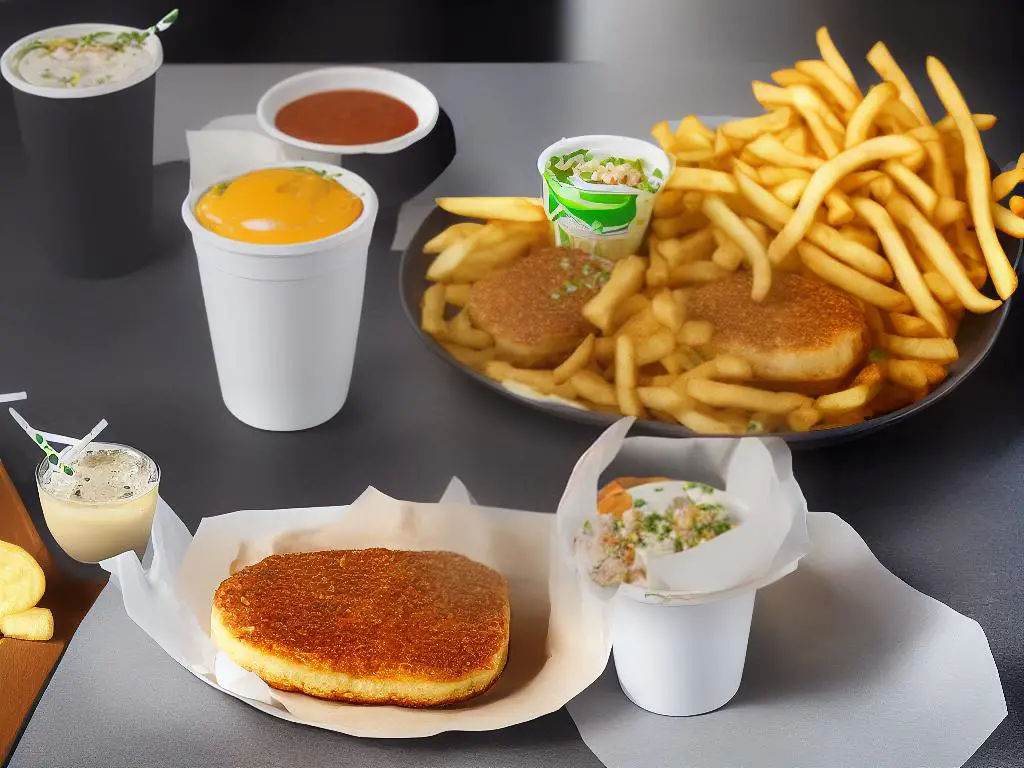McDonald’s, a renowned global brand, consistently adjusts its menu offerings to cater to regional tastes and preferences. One such product is the unique and flavoursome McKebab, which was introduced in McDonald’s Israel to entice local customers. In this essay, we explore the history of the McKebab and how it was developed as a fusion of traditional kebab flavours and McDonald’s fast-food culture. We delve into the ingredients and preparation of this delicious culinary creation, discuss its nutritional content and allergens, and analyse its market reception and customer reviews to provide a comprehensive understanding of its significance within the context of McDonald’s Israel. Additionally, we explore possible variations and future prospects for the product as the company continues to adapt to evolving trends.
History of McDonald’s Israel McKebab
The History of McDonald’s in Israel
The first McDonald’s branch opened in Tel Aviv in 1993, and today, there are over 180 branches across Israel. McDonald’s has adapted its menu to suit local tastes, and this has included the introduction of the popular McKebab in 2005.
The Introduction of the McKebab
The McKebab was introduced in response to the popularity of Middle Eastern flavours in Israel. McDonald’s conducted extensive research to develop a dish that would cater to local tastes while retaining the familiar McDonald’s flavour. The McKebab’s success has made it a popular dish on McDonald’s Israel’s menu.
Adapting the Menu to Local Tastes
McDonald’s Israel has introduced kosher-certified restaurants, vegetarian and vegan options, and has made a committed effort to source local ingredients. These efforts demonstrate McDonald’s strategic approach to catering to the unique tastes of the Israeli market and maintaining the core values of the brand.

Ingredients and Preparation of McKebab
Among the tailored menu items, the McDonald’s Israel McKebab stands out as an innovative and popular choice. This offering provides customers with a unique combination of traditional Mediterranean flavours and the convenience of fast-food, further exemplifying the brand’s successful adaptation to the preferences of the local clientele.
At the heart of this distinctive dish lies the kebab – tender, juicy pieces of meat that have been seasoned with a blend of aromatic spices.The kebab is typically made from a selection of meats, primarily lamb or beef, which are ground together and mixed with finely chopped onions, garlic, parsley, and a medley of spices such as paprika, cumin, coriander, and allspice, lending the McKebab its characteristic taste.In order to ensure that the McKebab maintains its succulent texture, the meat mixture is gently formed into patties and then chargrilled to perfection.This cooking technique not only imbues the McKebab with a rich, smoky flavour but also allows excess fat to drip away from the meat during the grilling process, resulting in a tasty and satisfying meal that is not overly greasy.The chargrilled patties are then placed on a bed of steamed rice or nestled inside a warm, pillowy pita, depending on the customer’s preference.Another integral component of the McKebab experience is the assortment of fresh, vibrant accompaniments that are served alongside the kebab.In keeping with the dish’s Mediterranean roots, the McKebab is accompanied by a variety of colourful, crunchy vegetables such as sliced tomatoes, cucumbers, onions, and lettuce.Additionally, the McKebab is typically served with a generous dollop of tahini sauce – a smooth, creamy condiment made from ground sesame seeds and lemon juice – which adds a tangy, nutty note that complements the bold flavours of the meat.As with all McDonald’s offerings, the McKebab is designed to be convenient, quick, and easy to eat on-the-go – a key factor that sets it apart from traditional kebab dishes.The patty format, in particular, lends itself well to the fast-food format; not only is it quicker to cook compared to a traditional shawarma spit, but it is also less messy and more portable, making it the ideal option for customers who are in a hurry or dining al fresco.In conclusion, the McDonald’s Israel McKebab is a unique and fitting addition to the chain’s menu, reflecting the country’s culinary landscape and catering to local tastes while still adhering to the brand’s commitment to fast, convenient, and satisfying meals.
The McDonald’s Israel McKebab serves as a prime example of how global brands can successfully adapt their offerings to suit local preferences without compromising on quality or identity.

Nutritional Information and Allergens
This popular menu item is offered by the fast-food giant in its Israeli branches, catering to local tastes and preferences. To ensure customers make informed decisions regarding their dietary choices, it is essential to note the nutritional information of the McKebab. It typically comprises a kebab-style spiced meat patty served in a flatbread with fresh vegetables, providing a unique and flavoursome alternative to a traditional burger.
The nutritional breakdown of the McKebab can provide an insight into its health impact. Based on average figures, the McKebab contains approximately 530 calories, with 15g of fat, including 4g of saturated fat. Additionally, it holds 62g of carbohydrates, 32g of protein, and roughly 1,000mg of sodium. It is essential to keep in mind that these figures may slightly differ depending on specific locations and individual serving sizes. Customers should be aware of their nutritional needs to ascertain whether these values fit within their daily dietary requirements.
Regarding allergens, the McKebab possesses potential allergens that could impact individuals with particular sensitivities or allergies negatively. The primary allergens to be aware of include gluten, dairy, egg, and soy, all of which are present in the flatbread and some of the condiments used in the dish. Individuals who have allergies or intolerances to any of these ingredients are recommended to exercise caution or avoid the McKebab altogether to prevent any adverse effects on their health.
In addition to the main McKebab ingredients, customers should be aware that the McDonald’s restaurants prepare their food in a shared kitchen environment. As a result, there are potential risks of cross-contamination with other allergens such as nuts, seeds, and fish, which may indirectly impact the McKebab’s final allergen content. Customers with severe allergies should always consult a member of staff or contact McDonald’s customer service to discuss the specific allergen precautions and practices in place at their desired location.
In summary, the McKebab is a unique McDonald’s menu item designed to cater to Israel’s local tastes, with a clear understanding of its nutritional content and potential allergen risks being crucial for individuals seeking to make informed dietary choices. It is important to be aware of the calorie, fat, carbohydrate, protein, and sodium content of the dish, in addition to potential allergens such as gluten, dairy, egg, and soy, ensuring a safe and enjoyable dining experience.

Market Reception and Customer Reviews
McDonald’s Israel introduced the McKebab in an effort to appeal to the local palate and has received mixed reviews since its launch. One of the factors contributing to its popularity is the consideration given to the taste preferences of Israeli customers by offering a McDonald’s take on a Middle Eastern classic. This demonstrated McDonald’s ability to adapt to and embrace the unique culinary desires of different cultures, potentially contributing to market success.
Upon its launch, some customers appreciated the McKebab for its unique spin on a traditional dish. Positive reviews often highlighted the flavourful combination of the kebab meat, vegetables, and sauces, which customers enjoyed as a quick service food option. The convenience and familiarity of the McDonald’s brand likely played a role in the initial popularity of the McKebab among fast food consumers.
However, the McKebab has also encountered criticisms and challenges due to comparisons with authentic, traditional Middle Eastern cuisine. Some critics deemed it a poor imitation of an authentic kebab and argue it falls short in terms of flavour and experience. Additionally, more discerning consumers of kebabs might have been hesitant to embrace a product from a fast-food chain known primarily for its Western-style options such as burgers and fries.
Another challenge faced by the McKebab was the fast-paced landscape of the food industry, where consumer preferences and trends can change rapidly. Many new food items typically experience an initial surge in popularity fuelled by novelty, but their longevity in the market depends on their ability to maintain a dedicated customer base. It is not unusual for fast food chains to introduce novel menu items as a means of generating buzz and attracting customers, although sustaining the popularity of these products over time can be difficult.
In Israel, the McDonald’s McKebab had attracted a mixed reaction from the general public. With some customers enjoying the novelty and convenience of a kebab offered by McDonald’s, others remained loyal to authentic kebabs from local establishments. In a competitive food market such as Israel’s, the introduction of McKebab required the fast-food giant to strive to carve out its niche and maintain customer interest. By conducting further analysis of the target demographic and assessing their preferences, insights could be provided into how the McKebab can continue to evolve and improve within the competitive Israeli market.

Variations and Future Prospects
A notable aspect of McDonald’s global success is the company’s ability to adapt their menu items to suit different markets and local tastes. The McKebab in Israel serves as a prime example of this, catering to the regional fondness for kebabs whilst incorporating McDonald’s traditional burger framework. In order to ensure the continued popularity of this product in Israel and potentially expand into other markets, it is essential for McDonald’s to explore variations and adaptations of the McKebab, taking into account customer feedback and changing market trends.
One such adaptation could involve the offering of different types of meat for the McKebab, which would cater to diverse preferences among customers. Currently, the McKebab is made with a combination of beef and lamb, but other popular options from Middle Eastern cuisine, such as chicken or turkey, could be incorporated into future iterations of this dish. This expansion of options could potentially boost sales and attract a wider range of customers to the McDonald’s Israel franchise.
Moreover, McDonald’s could also explore the inclusion of plant-based alternatives for the McKebab, in response to the growing trend of vegetarianism and veganism worldwide. Incorporating plant-based proteins into their menu can reflect McDonald’s commitment to environmental sustainability and attract a large customer base that follows these diets. High-quality plant-based McKebabs may also be appreciated by health-conscious consumers who are seeking better options within fast food menus.
In addition to playing with the core content of the McKebab, McDonald’s can further experiment with various regional and global flavours and sauces to accompany the McKebab. This would allow the company to cater to a broader range of tastes while encouraging customers to return and try out new flavour combinations. Special limited-time promotions or seasonal McKebab variations can keep the product fresh and interesting for regular patrons.
In terms of future prospects, the McKebab presents an opportunity for McDonald’s to bridge ethnic culinary divides and export the product to other countries where Middle Eastern cuisine is popular. The combination of traditional kebab flavours with a familiar McDonald’s burger form could appeal to a global audience, while being perceived as a unique fusion of different culinary traditions. Marketing the McKebab to broader or more diverse markets can be an effective way to strengthen McDonald’s presence and reputation for offering innovative, regionally-inspired dishes.

Throughout the essay, we have witnessed how McDonald’s Israel successfully navigated regional taste preferences through the introduction of the McKebab, a product that combines traditional kebab flavours with the fast-food format. The detailed analysis of its ingredients, preparation methods, nutritional values, and allergens shed light on the unique features and challenges associated with this innovative fusion of traditional and modern. Exploring its market reception, customer reviews, and potential variations revealed its popularity and adaptability as the brand continues to evolve. As the world of fast food expands and evolves, the McKebab stands as a testament to McDonald’s ability to cater to a diverse range of cultural preferences while maintaining its identity as a global food giant.
